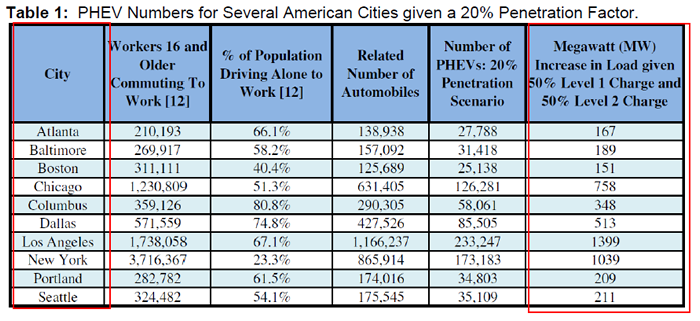While the addition of each Plug-in Hybrid Electric Vehicle (PHEV) to the street is a victory for the environment, their widespread adoption will present another potential challenge to the power distribution system, particularly in urban networks.
Impact of EVs on the Grid
Jack McCall | AMSC
What is the potential impact of EVs on the grid?
While the addition of each Plug-in Hybrid Electric Vehicle (PHEV) to the street is a victory for the environment, their widespread adoption will present another potential challenge to the power distribution system, particularly in urban networks. With as few as one car in five being PHEVs, smaller cities can see hundreds of MW of load added to their urban grids, with large cities seeing over 1 GW. See table. Urban distribution networks are often designed so that customers receiving electric power from a particular substation can only receive power from that substation. Upgrading space constrained urban substations to accommodate significant amounts of new load is often difficult or impossible, whether the load is from PHEVs or new commercial developments. And while urban networks are generally highly reliable, this single substation dependency makes them highly vulnerable to transformer failure events.

AMSC. (2010). Interconnecting substations via superconductor cables to accommodate PHEV related load growth. Retrieved from: http://ieeexplore.ieee.org/xpl/mostRecentIssue.jsp?punumber=5609172
How soon do you think we will be facing this issue?
 Adoption of PHEVs is now on the rise, and electricity use in general is increasing. As economic growth resumes, the issue will only be exacerbated.
Adoption of PHEVs is now on the rise, and electricity use in general is increasing. As economic growth resumes, the issue will only be exacerbated.
What solutions are available today to minimize the impact?
One solution available today is electrically paralleling urban distribution substations. This can simultaneously address both load growth and increase network resiliency. Cable connections between the medium voltage busses of adjacent substations can be used to transfer transmission-levels of power between them. This increases resilience to equipment failures and other events. It also increases the load serving capacity of the stations without the need for adding or upgrading transformers. Depending on the substation configuration, such a connection can theoretically increase load servicing capacity by 50-100% or more.
Why are superconductors required for this solution? Why not just use traditional conductors?
Conventional cables are not practical for this connection. The amount of power that must be transmitted is usually 4 – 10x the power capacity of traditional medium-voltage cables. Installing multiple sets of cables is difficult in urban areas where available underground right-of-way is limited due to the presence of gas, water, sewer, telecommunications, underground transit and other infrastructure. Even more significantly, when a fault occurs within the distribution network, additional fault current will flow from the paralleled substation through conventional cable, risking damage to equipment in the substations. Superconductor cables have a unique dual-personality: under normal conditions they conduct tremendous amounts of power very efficiently, but during faults, they can actually limit the amount of current that flows through them. This eliminates the risk of substation equipment damage from excessively high fault currents when paralleling substations. The installation of superconductor cable powered bus ties between distribution substations serve as an efficient means to utilize more effectively and fully the existing power delivery infrastructure while simultaneously increasing reliability.
What other reasons are there to justify the use of superconductors for utility applications?
Right-of-way is one key reason. A single superconductor cable can carry amounts of power normally associated with transmission voltage levels, therefore eliminating the need for multiple cables or overhead lines, greatly simplifying placement issues. In addition, superconductor cables emit no electric-magnetic fields. This combination of high power capacity and environmental compatibility make them the most space efficient and environmentally friendly of transmission technologies.
Is there a financial benefit to the utilities as well?
Yes, by paralleling two substations, utilities may not need to build another substation and therefore avoid the costs associated with such a large project.
When should utilities start thinking about implementing these types of solutions?
Utilities should start thinking about these solutions now. Electricity use is increasing, which will put greater strain on the current system.
Are superconductor cables in use anywhere in the world?
Yes. Dozens of pilot and demonstration projects throughout the world over the past 15 years proved the benefits of superconductor cables. In the United States, Long Island Power Authority (LIPA) has had a 138 kV system successfully operating in the grid since 2008. The cable is capable of carrying 574 MW of power in a right of way of only four feet. In Ohio, American Electric Power (AEP) has had a superconductor cable in operation since 2006. Korea is also rapidly moving ahead with superconductor technology, having just energized its first superconductor cable in September 2011. Korea now has three more projects in the works. Other countries installing or rapidly moving toward the installation of superconductor cables include Germany, Japan, China, Russia and India.
Are there other applications for HTS cables now, and do you see others arising in the future?
Yes, there are applications for HTS cables for electric utilities. In addition, HTS wire is being used for a wide variety of applications, including wind turbine generators and ship propulsion motors.
- Electric Utilities: "Smart” superconductor power cables are Ideal for transmitting and distributing both direct current (DC) and alternating current (AC), and can significantly boost power throughput, improve network efficiency, redundancy and reliability, reduce fault current levels and lower capital expenditures for electric utilities. Additionally, fault current limiters made with superconductors can help protect the grid by reducing the destructive nature of faults, thereby saving utilities equipment replacement and repair costs as well as avoiding outages and helping to ensure customer satisfaction.
- Wind turbine generators: The superior power density of HTS can enable smaller, lighter and more efficient wind generators that can be utilized to field higher power wind turbines and lower the overall cost of offshore wind power.
- Motors: Ultra-compact electric motors made with HTS tend to be half the size and weight or less of conventional copper-based motors of the same power and torque ratings. This can lead to significant space, weight and fuel savings for commercial and military applications, such as on ships.
Jack McCall is the Managing Director, Superconductor Power Systems for AMSC. Jack has over 25 years experience in the utility T&D business holding a variety of product engineering, product management, system engineering, business development, marketing, and strategic planning roles. He has his Master’s in Electric Power Engineering from Rensselaer Polytechnic Institute, Troy, NY, and his BSEE from Gannon University, Erie, PA. He is a member of the IEEE and CIGRE, and just joined the AWEA Transmission Committee.
The content & opinions in this article are the author’s and do not necessarily represent the views of AltEnergyMag
Comments (0)
This post does not have any comments. Be the first to leave a comment below.
Featured Product

